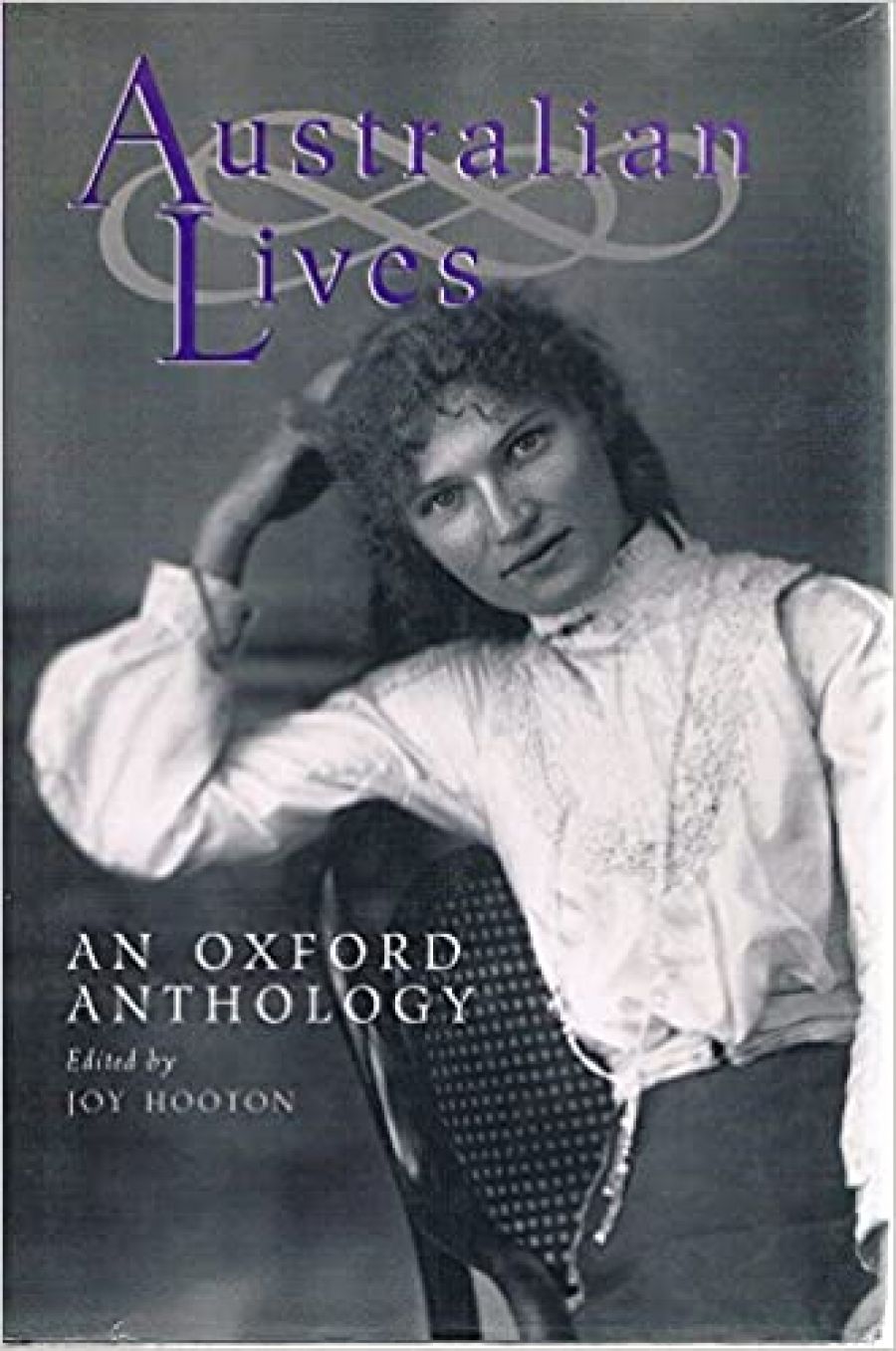
- Free Article: No
- Contents Category: Biography
- Review Article: Yes
- Online Only: No
- Custom Highlight Text:
Joy Hooton must know more about Australian autobiography than anyone else. Her critical and bibliographical works are now complemented by this marvellous anthology – humorous, plangent, and surprising. It replaces the more literary Penguin anthology by the Colmers (an important collection, though now somewhat outdated), and more than accounts for the period not dealt with in Gillian Whitlock’s impressive UQP anthology of contemporary Australian autobiography.
- Book 1 Title: Australian Lives
- Book 1 Subtitle: An Oxford Anthology
- Book 1 Biblio: OUP, $39.95 hb, 298 pp
Hooton’s sixty-five autobiographers range from colonial times to the present, and her thematic arrangement produces variety and new connections. Her introduction emphasises the two-way interaction between place and self that makes this nationalist anthology so fertile. She argues that
The tendency to treat autobiography chiefly as a branch of imaginative literature rather than as part of the general history of discourse is to emphasise artistic creation at the expense of the complexities of historical recreation and the intricacies of psychological and sociocultural influences.
Hooton’s editorial strength lies in her ability to see autobiographical discourse as a double discourse, determined by competing claims.
Hooton is suspicious of drawing large conclusions about Australian culture from a few autobiographies. Her broad selection offers manifold expressions of ‘Australianness’: we find Kate Jennings in NYC; Martin Boyd at the Front; Mary Rose Liverani’s acute rendering of familial displacement; Havelock Ellis’s almost-numinous account of isolation in the bush; Stella Bowen’s leaving of Ford Madox Ford; Jessie Simons’ account of surviving the sinking of the Vyner Brooke after its bombing by the Japanese; and so on.
It is important to recognise early how autobiography is being used here. The collection does not overly reflect on autobiography’s condition, its stylisation and turning of experience into rhetoric (where experience doesn’t precede rhetoric). The stylisation is there, but Hooton’s eye for story means that most of her examples are concerned with extraordinary things that ordinary people have experienced. The excerpts are often downright exciting, as in Morley Roberts’s account of surviving a hurricane on a sailing ship with an incompetent captain, drunk officers, and a mutinous crew.
Hooton’s introduction and her emphasis elsewhere on the ‘relational self’ should make clear why these extracts so often concern others. Autobiography, we might say, is biography, so that the extracts from Jack Davis, Graham McInnes, Hal Porter (inevitably), Peter Conrad, and others portray parents. Elsewhere the historical impulse is present: Vincent Buckley on the Depression, Eve Hogan on bush life, Eliza Davies on exploration, and William Linklater on black-white relations. Only occasionally does the wrangling with the self in selfreflexion make itself heard, as in David Martin’s comment that his younger self ‘could be my son or grandson’.
For me, the colonial accounts were (surprisingly) often the most riveting, perhaps because they were less familiar. What the collection implies (if we are to generalise) is an Australia that is hard, concerned with the exterior, adventurous, pragmatic, and humorous. This may sound disappointingly familiar, but in autobiography it is the detail that counts, so that dose attention to Hooton’s texts presents less familiar Australias, not only through presenting different characteristics, but also simply through individual tone, as in Bowen’s belief that ‘the exhilaration of falling out of love is not sufficiently extolled’.
I have few quibbles with Hooton’s choice of texts and their extracts. Her choice from Patsy Adam-Smith’s Goodbye Girlie seemed disappointingly abstract for a writer who deals so well with the concrete, and there being other writers who Hooton might have chosen to leaven the anecdotes that encrust this collection. There are a few notable omissions (like Sally Morgan, Ruby Ginibi Langford, and Patrick White) but there are numerous lesser-known pieces to make up for this. I missed Robin Eakin’s Aunts up the Cross and Robin Wallace-Crabbe’s magnificent A Man’s Childhood (published too recently for inclusion?). Occasionally extracts seemed too short, but overall Hooton fits in a tremendous amount without suggesting unnecessary compression. She is also skilful in not choosing the obvious extract from a text (A.B. Facey’s being a good example).
Hooton’s Australian Lives is exciting and her scholarship shines through in creative and accessible ways. It deserves the widest currency. It shows us that to better imagine the past we must better understand past imaginings, especially when those imaginings relate to what we call real life. For me though, it reinforces the sense of autobiography as a double discourse, where our legitimate desire to theorise on the basis of determinants such as class, historical period, and so forth can be affronted by the individuality of each account: its details, oddity, and expressions of being.


Comments powered by CComment